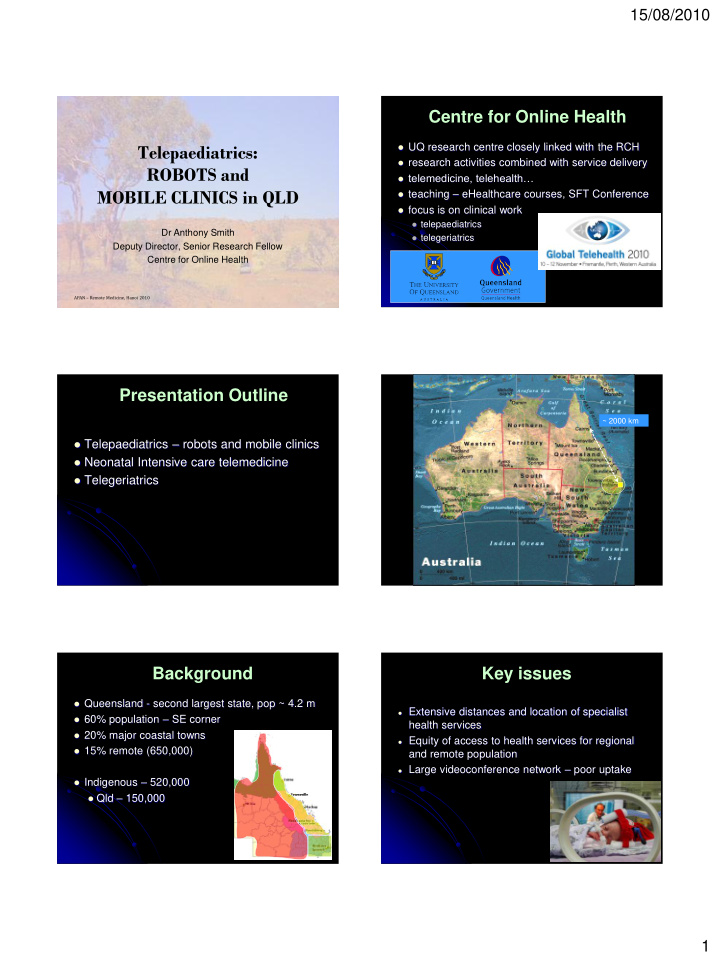



15/08/2010 Centre for Online Health Telepaediatrics: UQ research centre closely linked with the RCH research activities combined with service delivery ROBOTS and telemedicine, telehealth… MOBILE CLINICS in QLD teaching – eHealthcare courses, SFT Conference focus is on clinical work telepaediatrics Dr Anthony Smith telegeriatrics Deputy Director, Senior Research Fellow Centre for Online Health APAN – Remote Medicine, Hanoi 2010 Presentation Outline ~ 2000 km Telepaediatrics – robots and mobile clinics Neonatal Intensive care telemedicine Telegeriatrics Background Key issues Queensland - second largest state, pop ~ 4.2 m Extensive distances and location of specialist 60% population – SE corner health services 20% major coastal towns Equity of access to health services for regional 15% remote (650,000) and remote population Large videoconference network – poor uptake Indigenous – 520,000 Qld – 150,000 1
15/08/2010 Managing change... Telepaediatric Service Conventional models – entrenched in the health Incentive to provide telehealth services system – change needs to be carefully managed Clinical support service – not technology driven Telehealth needs to integrated with existing services – such as OPD sessions, inpatient support, outreach Appropriate clinical support systems need to be established Smith AC, Isles A, McCrossin R, Van der Westhuyzen J, Williams M, Woollett H and Wootton R. The point of referral barrier - a factor in the success of telehealth, Journal of Telemedicine and Telecare 2001; 7 (Suppl.2): 75-78 Telepaediatric Service Telepaediatric Service Over 10 years - since November 2000 Routine sub-specialist clinics Central referral centre - 1800 direct phone # Home telemedicine Telehealth coordination Email support NICU and PICU telemedicine Largest reported service of its kind in Australia Indigenous health screening Mobile systems – robots Benefits Lessons learnt Smith AC, Isles A, McCrossin R, Van der Westhuyzen J, Williams M, Woollett H and Wootton R. The point of referral barrier - a factor in the success of telehealth, Journal of Telemedicine and Telecare 2001; 7 (Suppl.2): 75-78 Telepaediatric Activity (8y) Neurology Neurology (n = 7602 consultations) 10% Respiratory ENT 6% Burns General Paediatrics 14% 6% Burns Ophthalmology 3% Diabetes Diabetes 3% Oncology 3% Child Psychiatry Orthopaedics 26% 2% Nephrology Cardiology 2% Dermatology 2% Oncology Cardiology Other 2% 21% 2
15/08/2010 Indigenous health Infant mortality - three times higher than the national average, or 15.2 deaths per 1,000 births compared to five per 1,000. Middle ear infections are very common Smith AC, Williams J, Agnew J, Sinclair S, Youngberry K and Wootton R. Real-time telemedicine for *Australian Indigenous Health Info Net paediatric ENT pre-admission screening. Journal of Telemedicine and Telecare 2005, 11 (Suppl. 2): 86-9 Indigenous health Indigenous health screening ~90% significant disease/deafness rate Community health services Visiting specialists Long-term impact: ENT 1-3y; severe disease burden (discomfort) Dental 4-5y; slow language Outreach – Dermatology 5-7y; slow learning physical travel Ophthalmology to remote sites 10-11y; behaviour problems, truancy Psychiatry 15y; illiteracy, substance abuse Respiratory Indigenous health screening Indigenous health screening Indigenous health workers To provide routine health screening for all Indigenous children in Cherbourg and Specialist outreach services and telehealth support surrounding communities ENT To develop a service which can be managed Dental locally by dedicated Indigenous health workers. Dermatology Ophthalmology To improve screening rates – above 90% Psychiatry Respiratory To ensure early detection (assessment) and treatment of chronic diseases. 3
15/08/2010 Indigenous health screening = Telepaediatric health screening unit C = Telepaediatric health screening clinic = Specialist site S = Database D C Woorabinda Biloela Moura Theodore Mundubbera Cherbourg Gayndah Murgon S Kingaroy D Telepaediatrics “on wheels” Indigenous health screening Community based screening programme led by Telepaediatric robots Indigenous health workers Commenced 2004 mobile, wireless Screening rates above 80% videoconference systems child-friendly Better understanding (quality data) of the health direct to bedside status of children in the community Community support and ownership Telepaediatric robots Telepaediatric robots 2005 – Gladstone Hospital, no paediatrician 2006 - 2008 funding to expand robot network daily ward rounds four new systems sub-specialist consultations paediatric support and education Smith AC, Coulthard M, Clark R, Armfield N, Taylor S, Goffe R, Mottarelly I, Youngberry K, Isles A and Smith AC, Coulthard M, Clark R, Armfield N, Taylor S, Goffe R, Mottarelly I, Youngberry K, Isles A and Wootton R. Wireless telemedicine for the delivery of specialist paediatric services to the bedside. Wootton R. Wireless telemedicine for the delivery of specialist paediatric services to the bedside. Journal of Telemedicine and Telecare 2005, 11 (Suppl. 2): 81-5 Journal of Telemedicine and Telecare 2005, 11 (Suppl. 2): 81-5 4
15/08/2010 Telepaediatric robots Logistics: All referrals centrally managed through the COH Systems operated over VPN, ISDN or DSL Tiny Tom - Townsville Eliza – Mt Isa Remote management of systems ROY – Gladstone Routine testing of systems and email alerts Emma - Emerald Gypsie – Gympie Telepaediatric robots Telepaediatrics 37 Clinical forums – up to 14 staff per session Children are cared for by local health services Average duration 30 min with the support of specialists by telemedicine – continuity of care COH - Brisbane Staff room - Emerald Harris V, Smith AC and Armfield N. e-Learning for regional health professionals using mobile videoconferencing in Queensland. Journal of Telemedicine and Telecare , 2007, 13 (Suppl. 3): 44-47 Practical tips… Critical factors Learn from experience – successes and failures Clinical services Develop new services systematically Infrastructure, equip and telecommunications Administrative and clinical systems New applications: Feasibility, technical, user satisfaction Clinical efficacy – comparable to FTF Economic evaluation – patient, health service, society Start small and gradually expand 5
15/08/2010 Conclusions QLD model is likely to be useful interstate and internationally Dr Anthony Smith Service delivery models should include a Deputy Director, Senior Research Fellow combination of telehealth, outreach, local and Centre for Online Health tertiary services Email: asmith@uq.edu.au Web: www.uq.edu.au Opportunities to strengthen clinical networks and deliver high quality specialist services in the most efficient manner APAN – Remote Medicine, Hanoi 2010 6
Recommend
More recommend